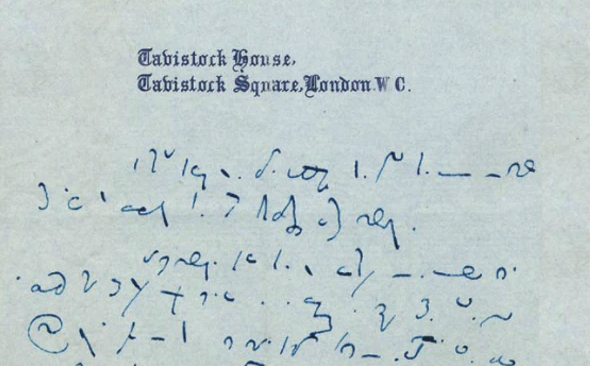Charles Dickens cryptogram solved
The “Dickens Project” has offered a prize for decoding a shorthand text by Charles Dickens. Apparently, the mystery has now been solved.
Last year I blogged about the Decoding Dickens Prize, created by the Dickens Project, an organization dedicated to the writer Charles Dickens (1812-1870) and his work.
The Tavistock Letter
The “Decoding Dickens Prize” was to be awarded to the person who could decode the following shorthand text by Charles Dickens, known as the “Tavistock Letter.”
Admittedly, I didn’t take the matter all that seriously. The message is recognizably written in shorthand, and I thought someone would be able to read it. I know that there used to be many different shorthands, some of which hardly anyone knows today, but I wouldn’t have suspected anything too exotic in Charles Dickens and Victorian England.
Apparently, however, the matter was then more difficult than I had expected. There was no one who could read the shorthand text easily. This could be due to the fact that Dickens extended and modified an already existing shorthand for his own purposes – just like his compatriot Samuel Pepys (1633-1703) did, whose shorthand diary could only be deciphered 120 years after his death.
Solved 60 percent
On February 7, 2022, the Dickens Project reported that the Tavistock letter had been deciphered. However, the press release stated that this was only true for about 60 percent of the text. Numerous readers from all over the world had deciphered parts of the text and sent them to the Dickens Project, where the fragments were put together. The most successful was a participant named Shane Baggs from San Jose (USA), who subsequently received the prize. Unfortunately, the press release does not say what this prize consisted of.
The Tavistock letter, it turns out, dates from 1859, referring to a planned newspaper advertisement with which Dickens disagreed. The recipient was to prevent the publication of the advertisement. This means that Dickens did not write the text for himself, but for a recipient who must also have mastered shorthand. The press release describes the contents of the letter as “strongly-worded,” but gives no details.
Apparently, there are at least ten other texts that Charles Dickens wrote in shorthand that have been preserved. As can be read on the Dickens Code page, some of them have not yet been deciphered.
All in all, the topic of Dickens and his shorthand texts seems quite interesting. Unfortunately, one finds only insufficient information on the linked websites. A compilation of solved and unsolved messages would certainly be helpful. If any reader has relevant information, I would be glad about a hint.
If you want to add a comment, you need to add it to the German version here.
Follow @KlausSchmeh
Further reading: Who can break this enciphered letter written by Albrecht von Wallenstein?
Linkedin: https://www.linkedin.com/groups/13501820
Facebook: https://www.facebook.com/groups/763282653806483/




Letzte Kommentare